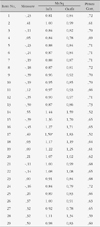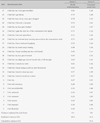1. Bond T.G., Fox C.M. Applying the Rasch Model: Fundamental Measurement in the Human Sciences. 2001. London: Lawrence Erlbaum Associates.
2. Chang S.B., Park S.M. A study on the relationship between emotions related to Pap smear and continuous participation Pap smear screening in married Korean women. Korean Journal of Women Health Nursing. 1999. 5(3):287–297.
3. Cho E.J. Effect of Desexualization Care guided by dramaturgical interaction on women's embarrassment during Uterine cervical cancer screening. 2003. Daegu: The Kyungpook National University of Korea;Unpublished doctoral dissertation.
4. Cho E.J., Chung B.Y. Embarrassment; A concept analysis. Journal of Korean Academy of Adult Nursing. 2002-a. 14(2):276–286.
5. Cho E.J., Chung B.Y. A descriptive survey on women's embarrassability and embarrassment during cervical screening. Journal of Korean Academy of Nursing. 2002-b. 32(6):832–843.
6. Consedine N.S., Krivoshekova Y.S., Harris C.R. Bodily embarrassment and judgment concern as separable factors in the measurement of medical embarrassment: Psychometric development and links to treatment-seeking outcomes. British Journal of Health Psychology. 2007. 12:439–462.
7. Consedine N.S., Ladwig I., Reddig M.K., Broadbent E.A. The many faeces of colorectal cancer screening embarrassment: Preliminary psychometric development and links to screening outcome. British Journal of Health Psychology. 2011. 16(3):559–579.
8. Consedine N.S., Reddig M.K., Ladwig I., Broadbent E.A. Gender and ethnic differences in colorectal cancer screening embarrassment and physician gender preferences. Oncology Nursing Forum. 11. 38(6):E409–E417. Retrieved November 22 2011. from
http://www.cinahl.com/cgi-bin/refsvc?jid=293&accno=2011334087.
9. Costa M., Dinsbach W., Manstead A.R., Bitti P.R. Social presence, embarrassment, and nonverbal behavior. Journal of Nonverbal Behavior. 2001. 25(4):225–240.
10. Edelmann R.J. Crozier W.R, editor. Embarrassment and blushing: A component-process model, some initial descriptive data and cross-cultural data. Shyness and embarrassment: Perspectives from social psychology. 1990. Cambridge: Cambridge University Press;205–229.
11. Goffman E. The presentation of self in everyday life. 1959. New York: Doubleday Anchor Book.
12. Goffman E. Interactional ritual; Essays on face-to-face behaviour. 1967. New York: Doubleday Anchor Book.
13. Ha F.I. Embarrassment and face work in Korean social interaction. 2000. Santa Barbara, USA: The University of California;Unpublished doctoral dissertation.
14. Henslin J., Biggs M. Henslin J, editor. Dramaturgical desexualisation: The sociology of the vaginal examination. Studies in the Sociology of Sex. 1971. New York: Appleton Century Crofts;136–160.
15. Kelly K.M., Jones W.H. Assessment of dispositional embarrassability. Anxiety, Stress, and Coping. 1997. 10:307–333.
16. Keltner D. Ekman P., Rosenberg E, editors. Signs of appeasement: Evidence for distinct displays of embarrassment, amusement, and shame. What the face reveals: Basic and applied studies of spontaneous expression using the facial action coding system (FACS). 1997. Oxford: Oxford University Press;133–160.
17. Kim H., Lee K., Lee S., Kim S. Uterine cervical cancer screening in Korean American women: Findings from focus group interviews. Journal of Korean Academy of Nursing. 2004. 34(4):617–624.
18. Ko Y., Malone D.C., D'Agostino J.V., Skrepnek G.H., Armstrong E.P., Brown M., Woosley R.L. Potential determinants of prescribers' drug-drug interaction knowledge. Research in Social and Administrative Pharmacy. 2008. 4(4):355–366.
19. Leary M.R., Kowalski R.M. Social anxiety: Self-Presentational disasters. 1995. New York: Guilford Press.
20. Linacre J.M., Wright B.D. WINSTEPS.Rasch-Model [computer program]. 1991. Chicago: MESA Press.
21. Linacre J.M. What do infit and outfit, mean-square and standardized mean? Rasch Measurement Transactions. 2002. 16(2):878.
22. Lodge N., Mallet. J., Blake P., Fryatt I. A study to ascertain gynecological patient's perceived levels of embarrassment with physical and psychological care given by female and male nurses. Journal of Advanced Nursing. 1997. 25:893–907.
23. Lynn M.R. Determination and quantification of content validity. Nursing Research. 1986. 35(6):382–385.
24. Moettus A., Sklar D., Tandberg D. The effect of physician gender on women's perceived pain and embarrassment during pelvic examination. American Journal of Emergency Medicine. 1999. 17(7):635–637.
26. Park S., Chang S., Chung C. Contents analysis on cognitive-affective experiences in Pap smear participants. Journal of the Korean Society of Maternal and Child Health. 2004. 8(1):37–48.
27. Park S.J., Park W.S. Identifying barriers to Papanicolaou smear screening in Korean women: Korean National Health and Nutrition Examination Survey 2005. Journal of Gynecologic Oncology. 2010. 21(2):81–86.
28. Patton K.R., Bartfield J.M., McErlean M. The effect of practitioner characteristics on patient pain and embarrassment during ED internal examinations. American Journal of Emergency Medicine. 2003. 21(3):205–207.
29. Waller J., Bartoszek M., Marlow L., Wardle J. Barriers to cervical cancer screening attendance in England: A population-based survey. Journal of Medical Screening. 2009. 16(4):199–204.







 PDF
PDF ePub
ePub Citation
Citation Print
Print




 XML Download
XML Download